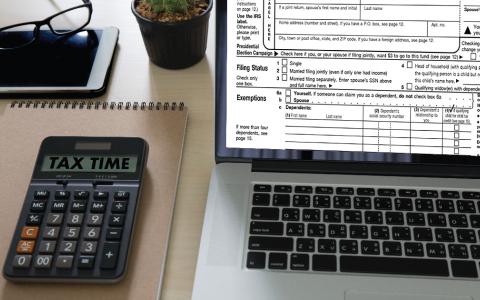
IRS Income Tax Day 2021 Deadline Extended? Learn More About E-Filing in Under 5 Minutes.
When is Tax Day 2021? Deadline Extended from April 15 to May 17: Here is What the IRS Wants You to Know about E-Filing Using Digital Signatures
It is that time of the year, folks. The annual financial headache of America. Unless you are due a hefty refund from the IRS or working as a highly paid accountant, Tax Day 2021 won’t bring much delight and happiness to your life. According to a NationalToday.com survey, 7% of Americans enjoy the filing process while 11% say that filing taxes absolutely stresses them out and surprisingly, 3% of them never file their taxes!
Evading tax is a criminal offense, if committed, may give rise to substantial monetary penalties, imprisonment, or both. Therefore, unlike the 3% of those people, we must abide by the law and file our taxes no matter how we feel. Today, we bring you fresh information on how the IRS wants you to file your taxes for Tax Day 2021 using digital signatures if you plan on e-filing to save a significant amount of time.
How does the e-signature option work?
Taxpayers who intend to use Forms 8878 or 8879 to electronically sign Form 1040 federal tax returns or filing extensions, can use an e-signature to sign and electronically submit these forms to their Electronic Return Originator (ERO).
Can all taxpayers use the e-signature option?
All taxpayers cannot use the e-signature option. It is only available to taxpayers who e-file their returns via an ERO that makes use of software to provide e-signature and identity verification. To meet the requirements for e-signature, the ERO should be able to record the name, social security number, date of birth, and address of the taxpayer electronically, to verify the ID.
Do taxpayers need to sign Forms 8878 or 8879 electronically?
No. Taxpayers can continue using handwritten signatures and send the form to the ERO via U.S. mail, email, fax, private delivery, through the internet, or in-person before Tax Day.
What e-signature methods are available?
The software the ERO uses decides the e-signature method used to sign the form. Irrespective of which method is used, the electronic record must be forgery-proof once it is e-signed. Examples of some of the methods used to capture e-signs include:
- A handwritten signature on an e-signature pad
- A command input, mark, or handwritten signature captured via a stylus, on a display screen
- A digitized image of a handwritten signature attached to an electronic record
- A typed name
- A shared secret such as a password, secret code, or PIN used to sign the digital record
- A digital signature
- A mark captured in the form of a graphic.
What are the ERO’s responsibilities regarding e-signatures?
When a taxpayer opts for an e-signature option, the ERO must use software wherein identity verification is included. It should be able to record the following data:
- Digital image of the signed form
- Date and time of the signature
- Taxpayer’s computer IP address (remote transaction only)
- Taxpayer’s login ID — username (remote transaction only)
- Results of the ID check to authorize the taxpayer’s ID verification
- The e-sign method used to sign the record
The ERO also holds responsibility for preserving a forgery-proof record in a safe, access-controlled storage system for 3 years from the IRS return receipt date or 3 years from the due date of the return, whichever falls at a later. ERO's must be able to recover and reproduce readable hard copies of the signed form.
Also read: Guide to Going Paperless with DrySign
How should the software perform identity verification?
For identity verification purposes, the software may generate a “soft inquiry” in the credit reporting industry. Information from the taxpayer’s credit report is used by credit reporting companies to create knowledge-based authentication questions – an action that may generate an entry on the credit report known as a “soft inquiry”. Characteristically, the knowledge-based authentication questions address the personal and financial history of the taxpayer. These are usually multiple-choice questions such as the name of their mortgage lender, type of car finance, a former address, or phone number. The taxpayer is expected to enter correct answers to the questions. This is not a credit check. However, taxpayers who fail to pass the ID verification check, can’t use e-signature.
Is identity verification a one-time event?
No, it is not a one-time event. Identity verification needs to be done each time a taxpayer signs Form 8878 or 8879 electronically. However, there are two exceptions. If a taxpayer electronically signs the form in the presence of the ERO, or there is a multi-year business relationship (when the ERO has initiated the taxpayer’s tax returns for a previous tax year and has already identified the taxpayer using the ID verification process) between the taxpayer and the ERO, identity verification is not needed on any Tax Day.
What is an “e-signature via remote transaction” with regards to Forms 8878 or 8879?
When the taxpayer e-signs the form and the ERO is not physically present, it is considered as a remote transaction for e-sign.
Note: A remote transaction for e-sign doesn’t include handwritten signs on Forms 8878 or 8879, sent to an ERO by U.S. mail, e-mail, fax, private delivery service, through the Internet, or in-hand.
What is Identity Verification Failure?
When an ERO makes use of tax preparation software to sign Form 8878 or 8879 electronically, the software facilitates identity verification using knowledge-based authentication questions. After three attempted failures to provide the correct answers to these questions, the ERO will need the taxpayer’s handwritten signature.
Now that the IRS has extended the Tax Day 2021 deadline from April 15 to May 17, you can easily e-file your taxes at your convenience using an ERO. Click here to contact your nearest ERO.
Sources: nationaltoday.com | irs.gov
Found this interesting? Share on your socials to let others know:
